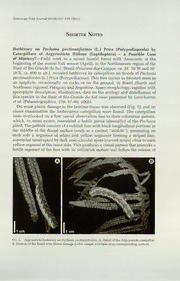
Herbivory on Pecluma pectinatiformis (L.) Price (Polypodiopsida) by Caterpillars of Argyrosticta Hübner (Lepidoptera) – a Possible Case of Mimicry? PDF
Preview Herbivory on Pecluma pectinatiformis (L.) Price (Polypodiopsida) by Caterpillars of Argyrosticta Hübner (Lepidoptera) – a Possible Case of Mimicry?
Shorter Notes Herbivory on Pecluma pectinatiformis Price (Polypodiopsida) by (L.) Caterpillars of Argyrosticta Hiibner (Lepidoptera) - a Possible Case — Mimicry? work mixed humid of Field in a forest with Araucaria, the at beginning of the austral Fall season (April), in the Northeastern region of the State of Rio Grande do Sul, Brazil (Princesa dos Campos, 28° 56'W and 50° ca. m 28'S, ca. 800 revealed herbivory by caterpillars on fronds oi Pecluma alt.), pectinatiformis (L.) Price (Polypodiaceae). This fern occurs in forested areas as an epiphyte, occasionally on rocks or on the ground, in Brazil (South and Southearn regions), Paraguay and Argentina. Spore morphology, with together sporophyte description, illustrations, data on the ecology and distribution of this species in the State of Rio Grande do Sul were presented by Lorscheitter et al. (Palaentographica, 270: 57-60. 2005). On some plants damage to the laminar tissue was observed and on (Fig. 1), closer examination the herbivorous were found. The caterpillars caterpillars were overlooked on due a first casual observation to their coloration pattern, which, some resembled pinna Pecluma to extent, a fertile (abaxially) of the The plant. pattern consists of a reddish line with black longitudinal portions in middle the of the dorsal surface (such as a central "midrib"), presenting on each side a sequence of white and yellow segments forming a striped line, somewhat interrupted by dark semi-circular spots (curved stripe) close to each yellow segment at the inner side. This produces a visual pattern that mimicks a segment fertile of the fern with yellowish mature sori before the release of its — AMERICAN FERN VOLUME NUMBER JOURNAL: 101 4 (2011) the spores. It is also possible that the dark semicircular marks simulate the between when incisions adjacent pinnae, the animal over reddish-brown the is frond rachis. The images were in Fig. 1 taken after disturbing the caterpillar, but the animal tends to stretch while feeding, thus having a width similar to that of the pinnae. Feces produced by the caterpillar dissolved in water and observed using an optical microscope, revealed the presence of spores morphologically On corresponding to those of host plant. a isolated plant, the development of one was of these caterpillars followed for 14 days (no mohing or changes in the color pattern were observed] up pupa humic to the stage the (in soil substrate), and hatching after another 28 days as an aduh moth. Entomologist Alfred Moser, classified the insect as a Noctuidae, genus Argyrosticta Hiibner (1821] meres A. (Druce, 1903] under were documented [cf. investigation]. All stages A through digital images. voucher has been deposited the ICN Herbarium at in Porto Alegre (ICN 167777]. A rapid survey of 32 herbarium sheets of this species revealed 15 with damages to the laminar tissue which could be attributed herbivory. to However, more attempts to find carterpillars in the field, on different were occasions, unsuccessful. There are still only few records of this kind of with interaction neotropical while opens ferns, this subject interesting and questions chalenges for future research (see Mehltreter in Mehltreter et ah, Fern Ecology, Cambridge University 232-235. Press, 2010). p. The authors thank the Conselho Nacional de Desenvolvimento Cientffico e - CNPq Tecnologico and the Coordenagao de Aperfeigoamento de Pessoal de - CAPES Nfvel Superior and work (grants field support). Special thanks are due Moser who to Alfred (Sao Leopoldo-RS, Brazil) kindly volunteered to identify the zoological material. Cristiano Buzatto provided welcome help with the digital images. Dr. Joanne Sharpe as well as anonymous reviewers contributed valuable suggestions. Michelle H. Nervo (corresponding author], em Pos-graduagao Qualidade Ambiental, Univ. Feevale, 93352-000 Novo Hamburgo-RS, Brazil (email: [email protected]); Paulo G. Windisch, bolsista Produtividade CNPq. Univ. Federal do Rio Grande do PPG Sul, - Botanica, 91540-970 Porto Alegre-RS, Suzana Brazil; Seibert, Pos-graduagao em - Biologia, Univ. Vale do Rio dos Sinos, 93.022-000 Sao Leopoldo RS, Brazil.
